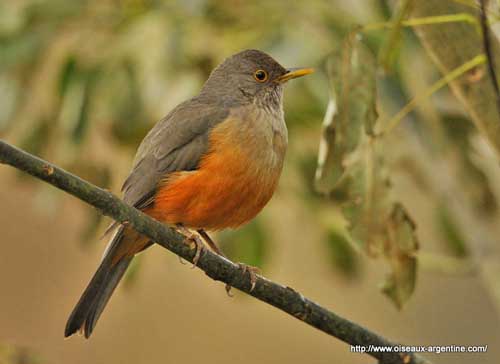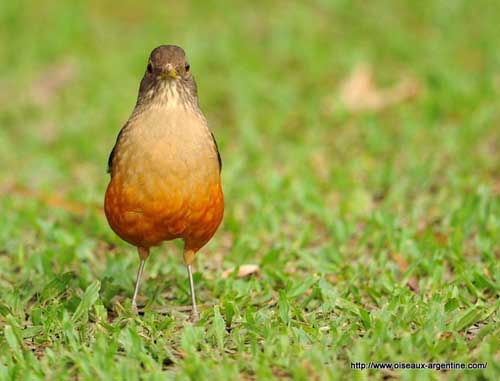
Fr: Merle à ventre roux
All : Rotbauchdrossel
Esp: Tordo de Vientre Rufo
Esp. (Argentine): Zorzal colorado
Esp. (Paraguay): Zorzal colorado
Esp. (Uruguay): Zorzal Común
Ital: Tordo rufiventre
Nd: Roodbuiklijster
Sd: Rostbukad trast
Port. (Brésil): Sabiá-laranjeira
Photographers :
Eduardo Andrés Jordan
MIS AVES – AVES DE ARGENTINA
Philippe and Aline Wolfer
OISEAUX D'ARGENTINE
Text by Nicole Bouglouan
Sources :
HANDBOOK OF THE BIRDS OF THE WORLD Vol 10 by Josep del Hoyo-Andrew Elliott-David Christie - Lynx Edicions - ISBN: 8487334725
THRUSHES by Peter Clement and Ren Hathway – HELM - ISBN: 0713639407
BIRDS OF SOUTH AMERICA – Passerines - by Robert S. Ridgely and Guy Tudor – HELM Field Guides – ISBN: 9781408113424
BirdLife International (BirdLife International)
JUMARA.com.ar - La conservación parte del conocimiento
SORA Searchable Ornithological Research Archive (Blair O. Wolf)
Wikipedia, la enciclopedia libre
Rufous-bellied Thrush
Turdus rufiventris
Passeriforme Order – Turdidae Family
BIOMETRICS:
Length: 23-25 cm
Weight: 78 g (68-82 g)
DESCRIPTION:
The Rufous-bellied Thrush is the National Bird of Brazil, officially chosen in 2002. This species is also known as Red-bellied Thrush. Its melodious song makes this bird very attractive for humans, and it is often kept as a cage bird in Brazil.
The adult male has olive-brown upperparts slightly washed greyish, including head and face. Wings and tail are browner.
On the underparts, chin and throat are white and finely streaked brown. The breast is mostly buffish to pale buffish-brown. Rest of underparts are bright orange to orange-rufous.
The bill is dull yellow, with dark base to upper mandible. The eyes are dark brown, surrounded by narrow orange-yellow eyering. Legs and feet are variably grey to light pinkish or purplish-horn.

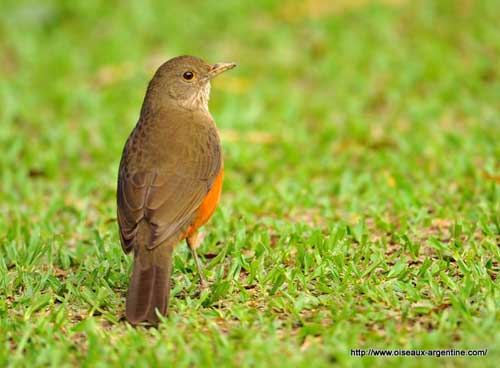
Both sexes are similar, with female slightly duller and with greyer bill.
The juvenile resembles adult on the upperparts, with buff streaks from crown to scapulars. Wing-coverts are tipped orange. The underparts from chin to belly are orange-buff with brown mottling to mid-belly, buffier and plainer from mid-belly to vent.
The immature has uniform upperparts, rufous lower underparts and spotted breast.
We can find two subspecies:
T.r. rufiventris (here described and displayed), is found in E Bolivia, S Brazil, Paraguay, N Argentina and Uruguay.
T.r. juensis is found in NE Brazil. This one is smaller with longer bill. It is paler above and has creamier breast.
VOICE: SOUNDS BY XENO-CANTO
The Rufous-bellied Thrush gives melodic song, a fast, rich carolling, often in the early morning before dawn. This song is usually given from hidden perch.
The song is typically slow, but during the breeding season, it becomes a loud melodious lilting series of varied phrases “koro koro-cheeere cheeeerie-tooodle” and a monotonous dialect song “dewee-dewo dewee-dewo, fewri-tewri…”
In non-breeding period, the song differs and becomes more resonant “juh-joeit, drew-wip, drew-wip, drew-wip…”
The call is a “djok, pup-pup, cluck cluck” or a rising, slightly slurred “dru-ip” or “dru-wip”. The alarm call is a sharp “tsri”. At dusk, we can hear chuckling or laughing notes.
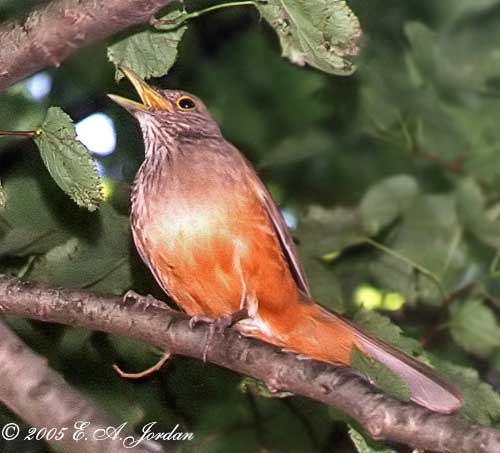
HABITAT:
The Rufous-bellied Thrush frequents the lowland humid woodlands and other wooded areas such as groves, plantations, clearings and edges of forests, bushy and scrubby patches. The species is visible from sea-level up to 2600 metres in Bolivia.
It may occur in gardens, urban parks and edges of cultivated fields. But in the drier regions of the range, it is often restricted to areas near water.
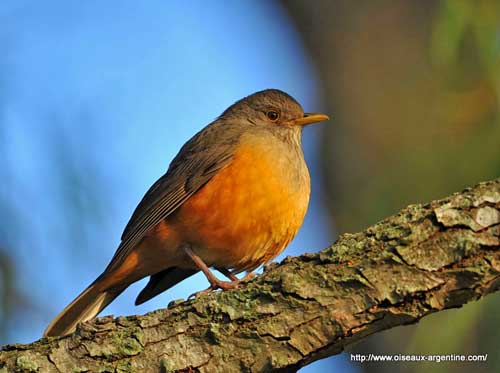
RANGE:
See above in “subspecies”
BEHAVIOUR:
The Rufous-bellied Thrush feeds mainly on invertebrates and fruits. Invertebrates include earthworms, woodlice, insects and spiders. Fruits include wild fruits such as berries from several plant species. This species is known to catch very small fish and freshwater shrimps.
It forages and feeds on the ground, often beneath the vegetal cover, and sometimes along the open borders of lagoons and pools.
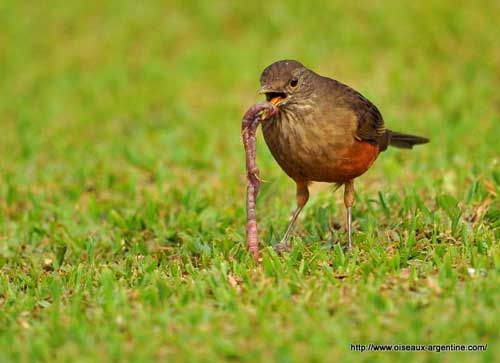
This species is usually shy, often hiding in the dense foliage. But when foraging, it can be seen hopping and running about near cover or on forest trails, paths and riverbanks.
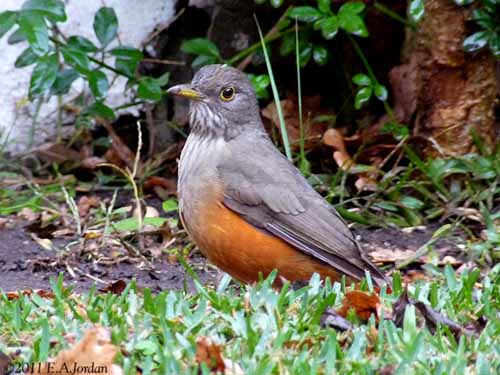
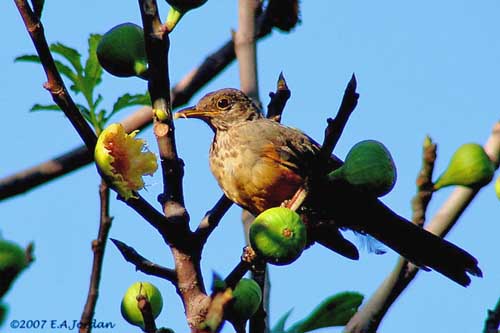
Like most Turdidae species, the Rufous-bellied Thrush is territorial and monogamous. Both mates remain together in winter, but in August or September, the male sings loudly prior to the nest-building. During this period, male’s underparts become brighter whereas the female appears duller.
They are living in pair all year round in their territory, sometimes sharing areas with other thrushes of the same species, but without more social behaviour.
This species is sedentary in its range. The breeding territory is maintained largely by songs, and the male sings during the whole nesting period, from August-September to December-January according to the range.
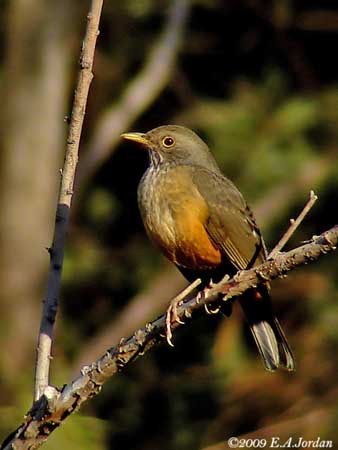
FLIGHT:
The Rufous-bellied Thrush performs short, fast, undulating flight.
REPRODUCTION:
The breeding season varies slightly according to the range.
The Rufous-bellied Thrush builds a large cup-shaped nest at 1-3 metres above the ground, in tree, close to the trunk. The structure is made with roots and plant fibres. The inner cup is lined with mud, dried grasses and twigs. The cup is often rimmed with cow dung.
Some nests can be different, with a cup made of hardened earth, or mostly of green moss, at various heights in trees or bushes.
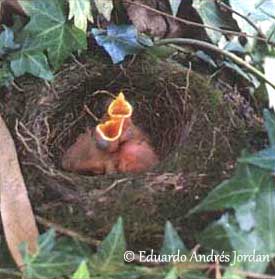
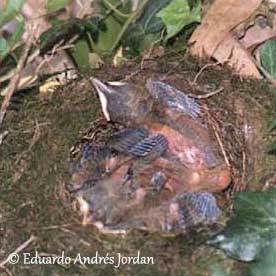
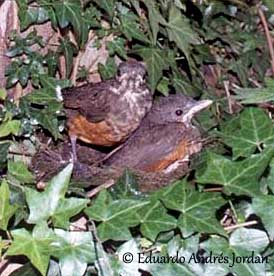
The female lays 3-4 bluish or greenish eggs with dark spots and blotches. Incubation by both adults lasts 13-15 days. The young are fed primarily on earthworms. They fledge 13-14 days after hatching and still depend on parents for two weeks more.
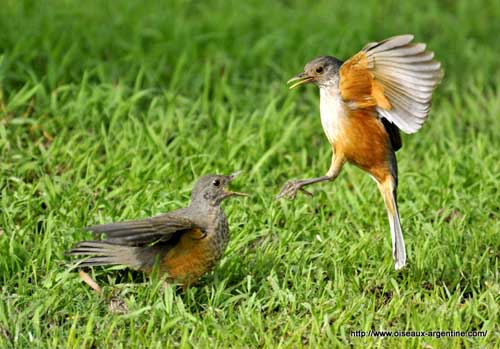
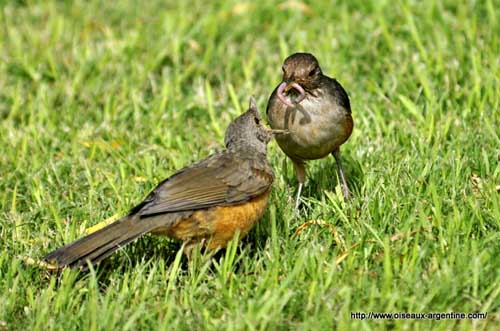
This species produces one or two broods per season according to the range.
The Shiny Cowbird often reduces the productivity by brood parasitism.
DIET:
The Rufous-bellied Thrush feeds primarily on earthworms and other invertebrates such as woodlice, spiders and insects including beetles, flies and ants. It also takes wild fruits such as berries from several plant species. It is known to catch very small fish and freshwater shrimps.
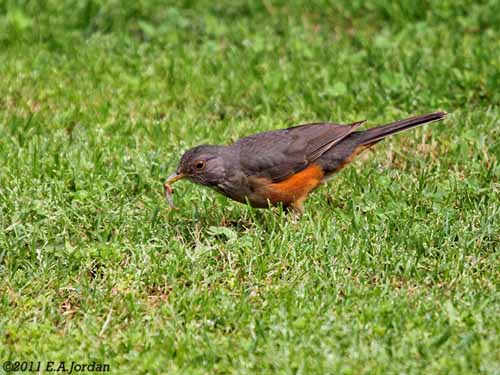
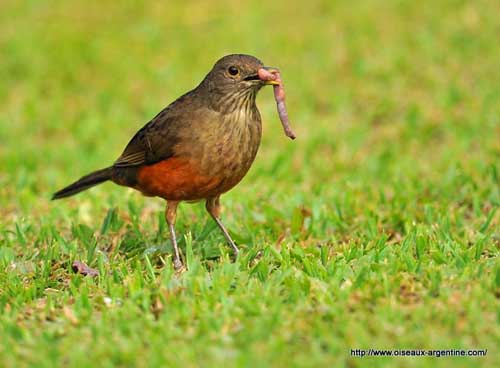
PROTECTION / THREATS / STATUS:
The Rufous-bellied Thrush is common in its range. This species is able to adapt to new areas due to deforestation and degradation of its habitat. Numbers are currently stable and this species is not globally threatened.
